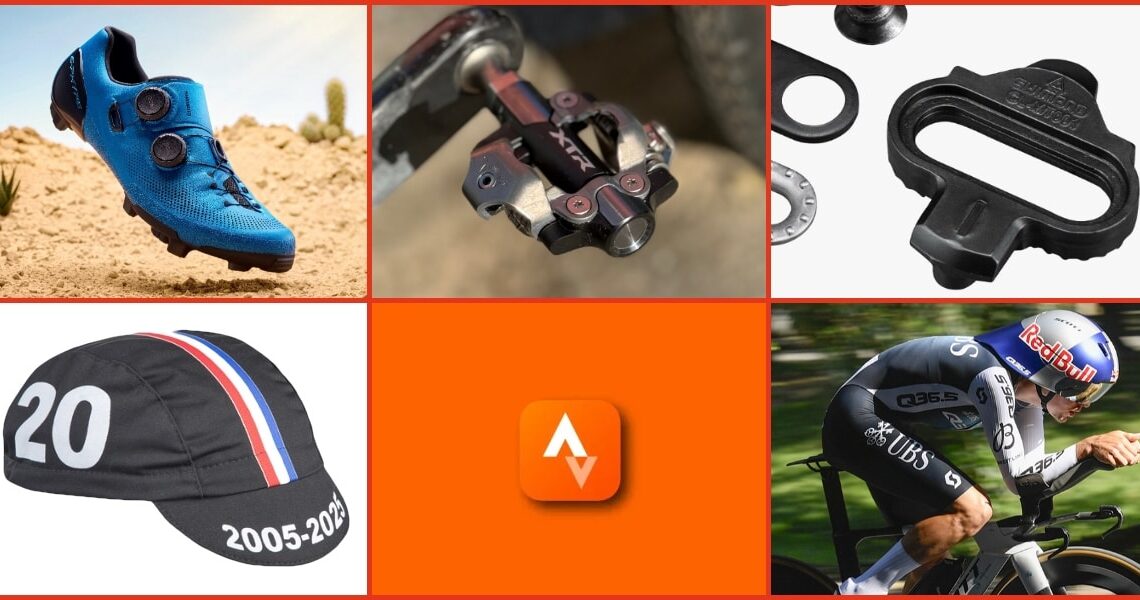
In this week’s Gear Break, August 29, 2025, we’ve got some exciting news from Shimano for their 2-bolt SPD line: a new gravel focused race shoe and a new multi-entry 2-bolt cleat, as well as a mini-review of the new top-end XTR PD-M9200 pedal. We are featuring the Scott Split MIPS TT helmet, as worn by the Tom Pidcock of the Q36.5 team in this week’s Stage 5 of La Vuelta a España 2025, Walz Caps 20th Anniversary including a limited release cap, and all the latest on Strava’s newest mapping update for the mobile app and additional training tools.
Shimano Launches RX910 S-PHYRE Gravel Race Shoe
Road-level power transfer, off-road capability, and all-day comfort
Shimano released the RX910 S-PHYRE yesterday aimed squarely at gravel riders, racers and performance oriented amateurs. Many of these riders are transitioning from tarmac and want a stiffer shoe offering maximal power transfer and the comfort they are accustomed to.

Gravel racing is inherently contradictory. Riders need road-level power transfer for long stretches of pedaling efficiency, but also often require off-bike traction for mud sections, river crossings, and technical terrain. Shimano’s new S-PHYRE RX910 gravel shoes resolve this contradiction, offering unmatched power transfer, walking stability, and all-day pedaling comfort in one streamlined package.
Born from the real-world demands of elite gravel athletes like Shimano pro gravel racer Pete Stetina, the RX910 draws on years of Shimano innovation in road, mountain, and gravel-specific cycling technologies. The shoe is not a compromise between road and mountain – it’s an entirely new solution engineered to meet the unique demands of gravel competition.

Pete Stetina Sez: “Sure, you can get away with road or MTB shoes for gravel racing. But to optimize for gravel performance, we need a light and stiff shoe that has a solid contact patch for steady power transfer plus the capability to handle the occasional hike-a-bike or muddy race.
“For me [the Pontoon Cleat System] is the most exciting point of this shoe. You now have road stability and power transfer while still having some off-road benefits of mud shedding and quick engagement of SPD.”
Revolutionary Pontoon Cleat System
At the heart of SHIMANO’S RX910 innovation is the new Pontoon Cleat System. This new feature includes a pair of modular, replaceable TPU contact blocks that dramatically improve the shoe-to-pedal contact point and optimize power transfer. The system enables a road-shoe-like pedaling interface while maintaining SPD compatibility and off-road functionality.
Unlike traditional outsole-mounted contact blocks, the RX910’s pontoons are part of the cleat interface itself. Designed to move with your cleat position – vertically or laterally – the pontoons provide consistent support and efficiency, no matter how your cleats are set up. As a bonus, the pontoons are replaceable, allowing riders to start every race with a solid shoe-pedal interface and providing long-term serviceability.

The RX910 is ideally paired with Shimnao SPD pedals. Best matches include the PD-M9200 (XTR) and PD-M8100 (XT) for seamless power delivery and dual-sided entry, which is a must for high-stakes remounts and technical terrain.
Beyond the Gravel Start Line
While the RX910 is engineered for elite gravel racing, it’s an excellent choice for performance-minded riders seeking a shoe that offers road efficiency and off-bike comfort. Whether you’re racing to beat the sun in Kansas, taking the lesser-known route to your local coffee shop, or exploring off-road, the RX910 is a compelling option for both performance and comfort.
SHIMANO S-PHYRE RX910 Product Specifications
- Weight: 304 grams (size 43)
- Color: Black, White, Blue, Deep Sea
- Stiffness: 12
- Standard Sizes: 38-48
- Half Sizes: 5-46.5
- Wide Sizes: 40-48
- MSRP: USD $480.00, EUR €419.95, GBP £419.95
The RX910 shoes are available through SHIMANO retailers and distributors worldwide, as well as online at Ride.Shimano.com.
Shimano CL-MT001 2-Bolt SPD Cleats – US$23.00
Multi-entry engagement meets enhanced walkability
Shimano unveiled the new CL-MT001 two-bolt SPD cleat yesterday, the first major update to its SPD cleat platform in nearly 30 years. Designed for a wide range of riders from modern trail and enduro racers to everyday commuters and new riders learning to clip in and out, the CL-MT001 provides multi-directional entry for easier engagement.
Since its introduction in 1995, the SM-SH51 cleat has become the trusted choice for millions of riders around the world. With advancements in pedal and shoe technologies, as well as evolving rider demands, SHIMANO took the opportunity to rethink its pedal/cleat interface from the ground up. The result is the CL-MT001, a cleat that blends the familiar reliability of SPD with modern versatility and ease of use.

Multi-Entry Functionality
Where the original SH51 cleat requires a toe-first, single-entry approach, the CL-MT001 allows riders to engage the pedal in multiple ways. That means you can clip into your pedal with the traditional front first then rear, or rear first then front, or simply stomp straight down and experience the quick and reliable connection between cleat and pedal.
This expanded engagement window is beneficial for a wide range of riders:
- Cyclocross and gravel racers will appreciate speedy remounts and their ability to quickly get back to pedaling and powering forward.
- Enduro riders and those who enjoy dynamic off-road conditions will appreciate the quick re-engagement that is critical after dismounts or foot dabs in technical terrain.
- Newer riders will also enjoy the intuitive clip-in experience with the added ease of multi-entry engagement.
Backwards Compatibility Built In
The new CL-MT001 cleat is fully backwards compatible with all existing two-bolt SHIMANO SPD pedal and shoe systems, allowing riders to experience improved performance and versatility with their current setup by simply swapping out their cleats.
Available at Ride.Shimano.com, or at your favorite local Shimano retailer.
Shimano XTR PD-M9200 Pedals – US$200
The pinnacle of 2-bolt SPD pedals
Let’s be honest, pedals are pretty much the most overlooked part of your setup, whether you’re out hammering on tarmac, grinding gravel, or bombing single-track. Well, overlooked in the sense that 3-bolt road pedals have their place, while 2-bolt pedals have theirs. The original SPD system, designed for use in the mountain biking world, provided riders a single, unified power transfer system to boost power to the pedal.

Fast forward 30 years, Shimano’s new XTR PD-M9200 pedals represent the pinnacle for clicking in to performance gravel and XC mountain biking.
Shimano sez: “Engineered to help you ride faster, the XTR PD-M9200 features a low platform height and wide bearing placement to create a stiff and stable interface for optimal pedaling efficiency and maximum power transfer. A slim axle housing and open binding design effectively shed mud and debris, delivering reliable performance even in the harshest race conditions.”


Is this pedal the pinnacle?
Andy R. Sez: In short: yes. The bigger question: do you need it? No, but you should 100% want it. Especially if you are racing or just chasing your local KOM. This pedal offers great power transfer with amazing stability.
The engagement and disengagement is crisp. I set them 4 clicks off of the lightest engagement setting and had no issues. Having ridden these on both XC and gravel, compared to the current generation XT PD-M8100, these are much easier to engage and disengage–both planned and unplanned.
In comparison to the prior generation XTR pedals (PD-M9100), these are better…at least in terms of how they felt. I am sure this is all in my head since these were nearly new. But, a Monday night gravel group ride out of the local brewery averaging 33 km/h, the power transfer was precise with no unwanted movement on top of the pedals.
Mud-shedding is something I’ve yet to really test in any sort of extreme. In mild mud conditions, however, as my cleats filled up, I had no issues getting these to engage and lock in. I also did not notice any profound change in the ability to disengage when mud had worked in between cleats and shoe pontoons.
I haven’t ridden these long enough to get to a point where I will need to service the spindle bearings. But, I suspect that this task will be much easier and potentially less frequent. Shimano have used sealed bearings so the pedal bodies will spin freely for thousands of miles (or kms in the rest of the world) around the chrome-molly spindles.
My only gripe–and it’s minor–the actual weight of the pedals was 5g more than the claimed weight (see photo and specs below). Is it a deal breaker? Absolutely not, it just isn’t. I’m only mentioning it because perfection is impossible, and some of us actually care about every single gram on our bikes.

XTR PD-M9200 Specs and Features
- Dual-Sided SPD
- Low-profile platform for greater stability
- Open mechanism for mud shedding
- Adjustable spring release tension for personalized engagement
- Weight: 315 grams (pair, standard axle, claimed) -> 320g actual
- Short axle version (-3mm) available to match the SPD-SL Q-factor aimed at road riders transitioning onto gravel
Verdict: buy these, then go back to concerning yourself with the other bits and parts that require your continued attention and care.
Celebrating 20 Years of Walz Caps
There are a lot of reasons to wear a cycling cap under your helmet. It prevents “helmet hair,” protects your head and eyes from the sun, prevents the potential for a bee sting on the crown, or it just looks properly Belgian. Regardless, your reason for wearing one, in the US and beyond, Walz has over the last 20 years established themselves as a leader in providing stylish and functional caps for cyclists. In recognition of that 20 year history, they have on offer now a trio of limited caps.
Before we get to those, let’s re-“cap” the last 20 years at Walz Caps.
Twenty years ago, their story began with Aunt Jackie Walz, who stitched cycling caps at home. They built a simple website, quit their day jobs, and took a leap of faith. Never did they imagine how far those first stitches would carry their company.

Who could have guessed that a full-page photo of our brown corduroy cycling cap would transform a small family effort into a respected brand known around the world? Over the years, their designs have grown and evolved, but the mission has stayed the same: to craft every cap with care, in San Diego. They’re still a small, family-run workshop, cutting and sewing each hat with love and precision.
Walz Caps Sez: “We know one thing for certain: we wouldn’t be here without you—our incredible community of riders who’ve supported us every mile of the way.”
Over those years, we at PezCycling News have made note of Walz Caps from time-to-time. It’s also worth taking a look back to 2017 when our very own Richard Pestes reviewed their custom build-a-cap program. Walz have since expanded the build-a-cap program.
In recognition of their 20 years, Walz is offering a limited edition 20th Anniversary cap with the purchase of any two regular caps.
SCOTT Split MIPS Helmet – €399.90
Built for speed. Designed for real-world race conditions.
Time trials and triathlons demand everything from riders, and their equipment. With the new Split MIPS helmet, SCOTT engineers set out with a single ambition: deliver the fastest, most adaptable helmet we’ve ever created. One that could meet the evolving needs of the world’s best athletes while giving every rider the power to tailor performance to their unique fit, discipline, and race conditions.
Working closely with aerodynamic experts and professional athletes, every line, vent, lens and skirt of the new helmet was analyzed through CFD and wind tunnel validation.
The result? A helmet that delivers proven aerodynamic gains, seamless integration, and real-world adjustability. Its unique Aero Reshape Concept, featuring interchangeable skirts, adjusts to each rider’s preferred position, while the visor’s integrated Amplifier Lens Technology delivers a sharper, clearer view with enhanced contrast in every condition.

No “One Size Fits All”
Aerodynamics in cycling isn’t one-dimensional. What works in the wind tunnel for a single test rider doesn’t always translate to real-world speed. From our development work across disciplines, and through ongoing feedback from our pro athletes and teams, it became clear: a helmet designed for just one rider, in one position, under ideal conditions, doesn’t reflect reality.
The demands of a 30-minute WorldTour time trial are entirely different from the hours-long effort of a full-distance triathlon. Riding positions vary, as do body shapes, cockpit setups, and weather conditions.
That’s why we didn’t set out to build the fastest helmet for a single scenario. Instead, we created a modular system that allows athletes to test, fine-tune, and tailor their helmet setup to their position, their race, and their reality.

Designed as a high-performance system
From the outset, the design philosophy behind Split MIPS was clear: everything serves speed and functionality. Every decision, every detail was made to support performance in the most demanding race scenarios, where comfort, aerodynamics, and usability must work together. Its proportions are unconventional for a reason. The form is shaped purely by function.
By prioritizing aerodynamic efficiency and real-world fit over traditional aesthetics, we created a helmet where performance leads and design follows.
One of the project’s greatest challenges was integrating the modular ARC system — visor, helmet, and interchangeable skirts — into a unified aerodynamic structure. The result is seamless, and the bold black line across the shell highlights exactly what this helmet represents: a clear break from the ordinary.
Split MIPS is a high-performance system in every sense: fast, comfortable, and uncompromising.
As of press time, there is limited availability of this helmet in Europe, and none in the US or Canada.
Strava Continues to Innovate
New subscriber features will add further capabilities to explore, level-up training and competing, and make friendly competition fairer
 Explore Easier
Explore EasierRoute Builder: Available from August 27, Strava is introducing a significant update to its Route Builder tool on Mobile. The interface has been fully redesigned to be more dynamic, making planning with precision faster than before. Powered by billions of activities, Strava’s Heatmap shows where fellow community members have actually cycled, run, hiked, or otherwise been active—users can therefore create routes with the confidence that they are informed by real, human-powered activity data.
The update will be rolling out over the next few days, and also brings with it brand new functions:
-
Enhanced Route Details: Users can move their finger along routes to see elevation, distance, surface type and grade, so they know what to expect when out on the roads, trails or paths.
-
Route Adjustment: It will be possible to add, move or delete waypoints— specific markers on a route, such as Tappable Points of Interest (think cafe stops, restrooms or viewpoints)—so that routes fit the exact needs of users.
-
Switch Sport-Types: The latest update makes it easier to transition from one sport type to another (such as road to gravel cycling) when creating routes to make planning that much simpler and more intuitive.
-
Power Skills: In the Progress tab on Strava, Power Skills is the first piece of The Breakaway being fully integrated into the Strava ecosystem after it was acquired earlier this year. This feature will enable cyclists who use a power meter (either on their own bikes, or through indoor cycling platforms) to receive individualized insights to train smarter and perform stronger through a visual breakdown of their all-time Power PRs across 12 notable cycling intervals, analysis on strength and growth areas, as well as skill and progression indicators. We’re also iterating on Power Skills: soon cyclists will be able to overlay their last 8 weeks of best efforts against their lifetime records. This will provide cyclists with greater understanding of their performances through power-based training—a precise, real-time measurement of cycling output—enabling them to fully optimize training and competing.
-
Training Zones: Removing the guesswork from training, the new Training Zones feature will provide cyclists and runners with easily understood insights into how much time they’re spending in each power, pace or heart rate zone, such as Zone 2, across a week, month or 3-month time period. This level of insight will help users balance effort and recovery to get in peak performance mode.

-
Leaderboard Integrity: As a result of introducing new machine learning models aimed at detecting irregular, improbable or impossible efforts, 4.45 million activities were removed from Strava’s leaderboards earlier this year, rightfully restoring KOMs and QOMs to reflect true performances of the global community. Since then, the company has continued its work to protect the authentic activities of its users. This latest update sees the detection and removal of E-Bike rides uploaded to ride or run Segment Leaderboards, so they only appear on E-Bike leaderboards instead. The result is E-Bike flag reports are down nearly 85%, as are overall flag reports on activities year on year.
Matt Salazar, Chief Product Officer, Strava, sez: “The introduction of these new updates, and fast integration of The Breakaway into the Strava ecosystem following its acquisition, is a demonstration of how we are investing in our global community of cyclists, in addition to runners. From deeper and more analytical personalized training insights, to enhanced routing and a fairer platform where competition can take place, these features now enable cyclists and runners to fully optimize every pedal stroke and stride they take in pursuit of their goals.”
Strava subscription pricing varies by region, you may sign up at Strava.com or on the mobile app available for Android and iOS.
The post Gear Break: Shimano Gravel shoes, cleats, and pedals, SCOTT Split MIPS helmet, Walz Caps at 20, and Strava updates appeared first on PezCycling News.





